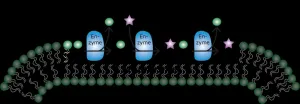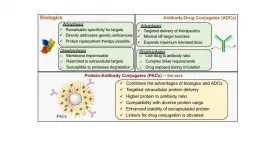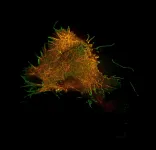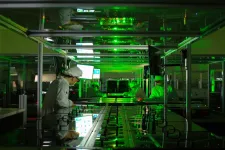INFORMATION:
The study, "Increased Diagnoses of Acute HIV Infection through Linking HIV Screening with COVID-19 Testing in an Urban Emergency Department During the Pandemic," was supported by funding from the Chicago Department of Public Health and Gilead Sciences, Frontlines of Communities in the United States Program. Additional authors include Moira McNulty, Jessica Schmitt, Dylan Eller, Jessica Ridgway, and Kathleen Beavis of the University of Chicago Medicine.
About the University of Chicago Medicine & Biological Sciences
The University of Chicago Medicine, with a history dating back to 1927, is one of the nation's leading academic health systems. It unites the missions of the University of Chicago Medical Center, Pritzker School of Medicine and the Biological Sciences Division. Twelve Nobel Prize winners in physiology or medicine have been affiliated with the University of Chicago Medicine. Its main Hyde Park campus is home to the Center for Care and Discovery, Bernard Mitchell Hospital, Comer Children's Hospital and the Duchossois Center for Advanced Medicine. It also has ambulatory facilities in Orland Park, South Loop and River East as well as affiliations and partnerships that create a regional network of care. UChicago Medicine offers a full range of specialty-care services for adults and children through more than 40 institutes and centers including an NCI-designated Comprehensive Cancer Center. Together with Harvey-based Ingalls Memorial, UChicago Medicine has 1,296 licensed beds, nearly 1,300 attending physicians, over 2,800 nurses and about 970 residents and fellows.
Visit UChicago Medicine's health and science news blog at http://www.uchicagomedicine.org/forefront. END
UChicago Medicine's ED maintains HIV screening despite pandemic interruptions
2021-05-06
(Press-News.org) While other medical systems across the country failed to maintain HIV screening volumes throughout the COVID-19 pandemic, the University of Chicago Medicine maintained screening volumes by including universal HIV screening alongside COVID-19 testing in its busy emergency department, according to a new report published April 12 in JAMA Internal Medicine. Through targeted efforts to maintain infrastructure and enthusiasm for HIV screening, the number of HIV tests remained at pre-pandemic levels while the rate of acute HIV diagnoses actually increased.
Widespread screening to diagnose individuals newly infected with HIV is a key part of Centers for Disease Control and Prevention's (CDC) plan to end the HIV epidemic in America. However, the COVID-19 pandemic presented a challenge, because changes to the logistics of running emergency departments during a pandemic led to reduced HIV screening across the country.
"At UChicago Medicine, we successfully maintained our screening volume because we implemented infrastructure to facilitate continued routine HIV screening alongside COVID-19 testing in our emergency department," said first author Kim Stanford, MD, MPH, Assistant Professor of Medicine.
"We wanted to test as many people as possible in the emergency department, and Kim's team was unique in having the foresight to include phlebotomy for HIV testing in evaluation of people who were otherwise being seen for COVID-19," said senior author David Pitrak, MD, Professor of Medicine.
The investigators found that the diagnosis rate of acute HIV infection at UChicago Medicine actually rose during the pandemic compared to the previous four years. Other emergency departments that did not implement HIV screening as a part of COVID-19 testing saw a reduction in their HIV diagnoses.
While UChicago Medicine did see a rise in the rate of new HIV diagnoses, which has large implications for public health, it is as of yet unclear what drove this increase.
"It's possible that through screening during a COVID-19 test, we are just detecting more infections than we would have otherwise, and there isn't actually more widespread transmission," said Pitrak "It's also possible that the pressures of social isolation and drop offs in routine visits for HIV care led people to engage in more high-risk behaviors, and that community transmission is actually up. We don't know yet, but finding that out will be important for strategizing how to continue to stem further HIV transmission."
The CDC recommends HIV screening as a part of emergency department visits, yet only about 2% of these visits nationally are actually associated with a test.
"Emergency departments really are the places in the medical center with the highest prevalence of undiagnosed HIV infection," said Pitrak.
According to Stanford, screening for HIV during emergency department visits is especially critical for people in low-resource settings, since they may be at elevated risk for HIV infection and may not undergo routine screening. That means an emergency department visit is a critical opportunity to diagnose new infections.
Both Pitrak and Stanford emphasized how critical it is for a HIV testing program to have strong advocates in both the emergency and infectious disease departments.
"You need a strong partnership between these two parts of the medical system for this type of screening program to succeed. Our teams have been able to work well together to implement this program," said Stanford.
"Many doctors think there are these barriers that prevent them from ordering testing: 'What do I do if the test comes back positive? How am I going to help these patients get care? How am I going to answer all of their questions?'" said Pitrak. "Here at UChicago Medicine, we have a strong program to link patients to care and make sure they can access needed resources, so doctors don't need to worry about any of these questions. It's all streamlined and handled for them."
Both Pitrak and Stanford see the strength of this program in both the ability to diagnose individuals who may not normally be screened and its use as a model for other screenings during emergency department visits.
"Some of these patients normally wouldn't have come in for testing, and only received a diagnosis because they visited the emergency department because they were concerned about having COVID-19," said Stanford.
The results of the HIV screening program also suggest that other screenings as part of emergency room visits may be similarly useful.
"Diabetes screenings would be especially useful here at UChicago Medicine, for example, given the high rates in our community," said Stanford. "This could be extremely valuable for helping patients with little access to resources get a proper diagnosis and get connected with necessary treatment before their condition becomes severe."
On the HIV front, UChicago Medicine is continuing to move forward. "We are building a plan to work with other emergency departments in Chicago to implement both HIV and Hepatitis C screening," said Pitrak. "This really has the potential to help patients across the region. It's very exciting."
ELSE PRESS RELEASES FROM THIS DATE:
The origin of reproductive organs
2021-05-06
Early in human development, during the first trimester of gestation, a fetus may have XX or XY chromosomes that indicate its sex. Yet at this stage a mass of cells known as the bipotential gonad that ultimately develops into either ovaries or testes has yet to commit to its final destiny.
While researchers had studied the steps that go into the later stages of this process, little has been known about the precursors of the bipotential gonad. In a new study published in Cell Reports and co-led by Kotaro Sasaki of Penn's School of Veterinary Medicine, an international team lays ...
Not so wicked after all?
2021-05-06
Although the fairy tale of the wicked stepmother is a tale as old as time, the effects of blending children with their new stepfamilies may not be as grim as once thought.
In fact, new research shows that stepparents are not at a disadvantage compared to their peers from single-parent households and actually experience better outcomes than their halfsiblings -- good news for the more than 113 million Americans that are part of a steprelationship.
Led by East Carolina University anthropologist Ryan Schacht and researchers from the University of Utah, the study, "Was Cinderella just a fairy tale? Survival differences between stepchildren and their half-siblings," is available in the May edition of the Philosophical Transactions ...
In the Alps, climate change affects biodiversity
2021-05-06
The European Alps is certainly one of the most scrutinized mountain range in the world, as it forms a true open-air laboratory showing how climate change affects biodiversity. Although many studies have independently demonstrated the impact of climate change in the Alps on either the seasonal activity (i.e. phenology) or the migration of plants and animals, no systematic analysis has been carried out on both consequences simultaneously. A European team of ecologists1, including Jonathan Lenoir, CNRS Researcher in the research unit Écologie et Dynamique des Systèmes Anthropisés (CNRS/University of Picardie Jules Verne), has just published a review that ...
Archaeal enzyme that produces membrane lipids is spectacularly promiscuous
2021-05-06
Cells of all life forms are surrounded by a membrane that is made of phospholipids. One of these are the cardiolipins, which form a separate class due to their unique structure. When studying the enzyme that is responsible for producing cardiolipins in archaea (single-cell organisms that constitute a separate domain of life), biochemists at the University of Groningen made a surprising discovery. A single archaeal enzyme can produce a spectacular range of natural and non-natural cardiolipins, as well as other phospholipids. The results, which show potential for biotechnological applications, ...
India's polio vaccination provides valuable insights for mass vaccination campaigns
2021-05-06
Lessons Learned from India's Polio Vaccination Program Provide Valuable Insights for Future Mass Vaccination Initiatives.
Toronto - As India urgently scales up its vaccination campaign for the COVID-19 virus, a new study which examined the country's successful program to eliminate polio provides guidance on how this and future mass immunization campaigns can be successful, especially in vaccinating hard to reach groups.
The study, conducted by students and faculty with the Reach Alliance, a research initiative based at the University of Toronto's Munk School of Global Affairs & Public Policy, says that medicine alone is insufficient for the elimination of disease.
The World Health Organization declared India polio-free in 2014. ...
Research breakthrough in the fight against cancer
2021-05-06
AMHERST, Mass. - A team of researchers at the Center for Bioactive Delivery at the University of Massachusetts Amherst's Institute for Applied Life Sciences has engineered a nanoparticle that has the potential to revolutionize disease treatment, including for cancer. This new research, which appears today in Angewandte Chemie, combines two different approaches to more precisely and effectively deliver treatment to the specific cells affected by cancer.
Two of the most promising new treatments involve delivery of cancer-fighting drugs via biologics or antibody-drug conjugates (ADCs). Each has its own advantages and limitations. Biologics, such as protein-based ...
The COVID-19 pandemic: Even mild disease impacts mental health
2021-05-06
May 6, 2021 -- A significant level of symptoms of depression, anxiety and post-traumatic stress may follow COVID-19 independent of any previous psychiatric diagnoses, according to new research by Columbia University Mailman School of Public Health with colleagues at Universidade Municipal de São Caetano do Sul in Brazil. Exposure to increased symptomatic levels of COVID-19 may be associated with psychiatric symptoms after the acute phase of the disease. This is the largest study to evaluate depressive, anxiety, and post-traumatic stress symptoms in tandem among patients who had mild COVID-19 ...
New boost in quantum technologies
2021-05-06
Quantum computers or quantum sensors consist of materials that are completely different to their classic predecessors. These materials are faced with the challenge of combining contradicting properties that quantum technologies entail, as for example good accessibility of quantum bits with maximum shielding from environmental influences. In this regard, so-called two-dimensional materials, which only consist of a single layer of atoms, are particularly promising.
Researchers at the new Center for Applied Quantum Technologies and the 3rd Institute of Physics at the University of Stuttgart have now succeeded in identifying promising quantum bits in these materials. They were able to show that the quantum bits can be generated, read out and coherently controlled in a very ...
Blocking viruses' exit strategy
2021-05-06
The Marburg virus, a relative of the Ebola virus, causes a serious, often-fatal hemorrhagic fever. Transmitted by the African fruit bat and by direct human-to-human contact, Marburg virus disease currently has no approved vaccine or antivirals to prevent or treat it.
A team of researchers is working to change that. In a new paper in the journal Antimicrobial Agents and Chemotherapy, investigators from Penn's School of Veterinary Medicine, working together with scientists from the Fox Chase Chemical Diversity Center and the Texas Biomedical Research Institute, report encouraging results from tests of an experimental ...
Researchers produce laser pulses with record-breaking intensity
2021-05-06
WASHINGTON -- Researchers have demonstrated a record-high laser pulse intensity of over 1023 W/cm2 using the petawatt laser at the Center for Relativistic Laser Science (CoReLS), Institute for Basic Science in the Republic of Korea. It took more than a decade to reach this laser intensity, which is ten times that reported by a team at the University of Michigan in 2004. These ultrahigh intensity light pulses will enable exploration of complex interactions between light and matter in ways not possible before.
The powerful laser can be used to examine phenomena believed to be responsible for ...






